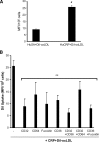Human C-reactive protein promotes oxidized low density lipoprotein uptake and matrix metalloproteinase-9 release in Wistar rats
- PMID: 18245817
- PMCID: PMC2311439
- DOI: 10.1194/jlr.M700535-JLR200
Human C-reactive protein promotes oxidized low density lipoprotein uptake and matrix metalloproteinase-9 release in Wistar rats
Abstract
C-reactive protein (CRP) is present in the atherosclerotic plaques and appears to promote atherogenesis. Intraplaque CRP colocalizes with oxidized low density lipoprotein (OxLDL) and macrophages in human atherosclerotic lesions. Matrix metalloproteinase-9 (MMP-9) has been implicated in plaque rupture. CRP promotes OxLDL uptake and MMP induction in vitro; however, these have not been investigated in vivo. We examined the effect of CRP on OxLDL uptake and MMP-9 production in vivo in Wistar rats. CRP significantly increased OxLDL uptake in the peritoneal and sterile pouch macrophages compared with human serum albumin (huSA). CRP also significantly increased intracellular cholesteryl ester accumulation compared with huSA. The increased uptake of OxLDL by CRP was inhibited by pretreatment with antibodies to CD32, CD64, CD36, and fucoidin, suggesting uptake by both scavenger receptors and Fc-gamma receptors. Furthermore, CRP treatment increased MMP-9 activity in macrophages compared with huSA, which was abrogated by inhibitors to p38 mitogen-activated protein kinase, extracellular signal-regulated kinase (ERK), and nuclear factor (NF)-kappaB but not Jun N-terminal kinase (JNK) before human CRP treatment. Because OxLDL uptake by macrophages contributes to foam cell formation and MMP release contributes to plaque instability, this study provides novel in vivo evidence for the role of CRP in atherosclerosis.
Figures






References
-
- Croce K., and P. Libby. 2007. Intertwining of thrombosis and inflammation in atherosclerosis. Curr. Opin. Hematol. 14 55–61. - PubMed
-
- Jialal I., S. Devaraj, and S. K. Venugopal. 2004. C-reactive protein: risk marker or mediator in atherothrombosis? Hypertension. 44 6–11. - PubMed
-
- Verma S., S. Devaraj, and I. Jialal. 2006. Is C-reactive protein an innocent bystander or proatherogenic culprit? C-reactive protein promotes atherothrombosis. Circulation. 113 2135–2150. - PubMed
-
- Ishikawa T., K. Hatakeyama, T. Imamura, Y. Shibata, Y. Hikichi, Y. Asada, and T. Eto. 2003. Involvement of CRP obtained by directional coronary atherectomy in plaque instability and developing restenosis in patients with stable or unstable angina pectoris. Am. J. Cardiol. 91 287–292. - PubMed
-
- Ballou C. P., and G. Lozanski. 1992. Induction of inflammatory cytokine release from cultured human monocytes by CRP. Cytokine. 4 361–368. - PubMed
Publication types
MeSH terms
Substances
Grants and funding
LinkOut - more resources
Full Text Sources
Research Materials
Miscellaneous

